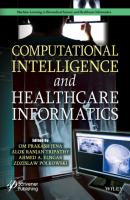Computational Intelligence and Healthcare Informatics. Группа авторов
Чтение книги онлайн.

Читать онлайн книгу Computational Intelligence and Healthcare Informatics - Группа авторов страница 15
Название: Computational Intelligence and Healthcare Informatics
Автор: Группа авторов
Издательство: John Wiley & Sons Limited
Жанр: Программы
isbn: 9781119818694
isbn:
4. Xing, L., Krupinski, E.A., Cai, J., Artificial intelligence will soon change the landscape of medical physics research and practice. Med. Phys., 45, 5, 1791–1793, 2018.
5. Deo, R.C., Machine Learning in Medicine. Circulation, 132, 20, 1920–1930, 2015.
6. Kannel, W.B., Doyle, J.T., McNamara, P.M., Quickenton, P., Gordon, T., Precursors of sudden coronary death. Factors related to the incidence of sudden death. Circulation, 51, 606–613, 1975, [PubMed] [Google Scholar].
7. Lip, G.Y.H., Nieuwlaat, R., Pisters, R., Lane, D.A., Crijns, H.J.G.M., Refining clinical risk stratification for predicting stroke and thromboembolism in atrial fibrillation using a novel risk factor-based approach: the euro heart survey on atrial fibrillation. Chest, 137, 263–272, 2010, [PubMed] [Google Scholar].
8. O’Mahony, C., Jichi, F., Pavlou, M., Monserrat, L., Anastasakis, A., Rapezzi, C., Biagini, E., Gimeno, J.R., Limongelli, G., McKenna, W.J., Omar, R.Z., Elliott, P.M., A novel clinical risk prediction model for sudden cardiac death in hypertrophic cardiomyopathy (HCM risk-SCD). Eur. Heart J., 35, 2010–2020, 2014, [PubMed] [Google Scholar].
9. National Research Council (US), Committee on A Framework for Developing a New Taxonomy of Disease, in: Toward Precision Medicine: Building a Knowledge Network for Biomedical Research and a New Taxonomy of Disease, National Academies Press (US), Washington (DC), 2011, [PubMed] [Google Scholar].
10. Woodruff, P.G., Modrek, B., Choy, D.F., Jia, G., Abbas, A.R., Ellwanger, A., Koth, L.L., Arron, J.R., Fahy, J.V., T-helper type 2-driven inflammation defines major subphenotypes of asthma. Am. J. Respir. Crit. Care Med., 180, 388–395, 2009, [PMC free article] [PubMed] [Google Scholar].
11. Corren, J., Lemanske, R.F., Hanania, N.A., Korenblat, P.E., Parsey, M.V., Arron, J.R., Harris, J.M., Scheerens, H., Wu, L.C., Su, Z., Mosesova, S., Eisner, M.D., Bohen, S.P., Matthews, J.G., Lebrikizumab treatment in adults with asthma. N. Engl. J. Med., 365, 1088–1098, 2011, [PubMed] [Google Scholar].
12. Laine, S. and Aila, T., Temporal ensembling for semi-supervised learning, in: International Conference on Learning Representations, 2017.
13. Cheplygina, V., d. Bruijne, M., Pluim, J.P.W., Not-so-supervised: a survey of semi-supervised, multi-instance, and transfer learning in medical image analysis. Medical Image Analysis, 54, 280–296, 2019.
14. Bai, W., Oktay, O., Sinclair, M., Suzuki, H., Rajchl, M., Tarroni, G., Glocker, B., King, A., Matthews, P.M., Rueckert, D., Semisupervised learning for network-based cardiac mr image segmentation, in: Medical Image Computing and Comput.-Assisted Intervention, pp. 253–260, Springer, Heidelberg, 2017.
15. Zhang, Y., Yang, L., Chen, J., Fredericksen, M., Hughes, D.P., Chen, D.Z., Deep adversarial networks for biomedical image segmentation utilizing unannotated images, in: Medical Image Computing and Comput.-Assisted Intervention, pp. 408–416, Springer, 2017.
16. Sun, W., Tseng, T.B., Zhang, J., Qian, W., Computerized breast cancer analysis system using-three stage semi-supervised learning method. Comput. Methods Programs Biomed., 135, 77–88, 2016.
17. Xia, Y., Liu, F., Yang, D., Cai, J., Yu, L., Zhu, Z., Xu, D., Yuille, A., Roth, H., 3d semi-supervised learning with uncertainty-aware multiview co-training, in: IEEE Winter Conf. Appl. Comput. Vis., 2020.
18. Zhao, Y., Zeng, D., Socinski, M.A., Kosorok, M.R., Reinforcement learning strategies for clinical trials in nonsmall cell lung cancer. Biometrics, 67, 4, 1422–33, 2011 Dec.
19. Pineau, J., Guez, A., Vincent, R., Panuccio, G., Avoli, M., Treating epilepsy via adaptive neurostimulation: a reinforcement learning approach. Int. J. Neural Syst., 19, 4, 227–40, 2009.
20. Liu, Y., Logan, B., Liu, N., Xu, Z., Tang, J., Wang, Y., Deep reinforcement learning for dynamic treatment regimes on medical registry data. 2017 IEEE International Conference on Healthcare Informatics (ICHI), 2017 Aug., pp. 380–5.
21. Raghu, A., Komorowski, M., Ahmed, I., Celi, L.A., Szolovits, P., Ghassemi, M., Deep reinforcement learning for sepsis treatment. CoRR, 2017, abs/1711.09602.
22. https://news.stanford.edu/2017/01/25/artificial-intelligence-used-identify-skin-cancer (dated: 13-09-2020)
23. Gulshan, V., Peng, L., Coram, M. et al., Development and Validation of a Deep Learning Algorithm for Detection of Diabetic Retinopathy in Retinal Fundus Photographs. JAMA, 316, 22, 2402–2410, 2016.
24. Dash, S.S., Big data in healthcare: management, analysis and future prospects. J. Big Data, 6, 54, 2019.
25. Johnston, L.R. and P.L., Suboptimal response to clopidogrel and the effect of prasugrel in acute coronary syndromes. Int. J. Cardiol., 995–999, 2013.
26. Sean Chia, J.H., SAR by kinetics for drug discovery in protein misfolding diseases. PNAS, 2018.
1 *Corresponding author: [email protected]
2
Thoracic Image Analysis Using Deep Learning
Rakhi Wajgi1*, Jitendra V. Tembhurne2 and Dipak Wajgi2
1Department of Computer Technology, Yeshwantrao Chavan College of Engineering, Nagpur, India
2Department of Computer Science & Engineering, Indian Institute of Information Technology, Nagpur, India
Abstract
Thoracic diseases are caused due to ill condition of heart, lungs, mediastinum, diaphragm, and great vessels. Basically, it is a disorder of organs in thoracic region (rib cage). Thoracic diseases create severe burden on the overall health of a person and ignorance to them may lead to the sudden death of patients. Lung tuberculosis is one of the thoracic diseases which is accepted as worldwide pandemic. Prevalence of thoracic diseases is rising day by day due to various environmental factors and COVID-19 has trigged it at higher level. Chest radiography is the only omnipresent solution utilized to capture the abnormalities in the chest. It requires periodic visits by patient and timely tracking of findings and observations from the chest radiographic reports. These thoracic disorders are classified under various classes such as Atelectasis, Pneumonia, Hernia, Edema, Emphysema, Cardiomegaly, Fibrosis, Pneumothorax, Consolidation, Pleural Thickening, Effusion, Infiltration, Nodules, and Mass. Precise and reliable detection of these disorders required experienced radiologist. The major area of research in this domain is accurate localization and classification of affected region. In order to make accurate prognosis of chest diseases, research community has developed various automated models using deep learning. Deep learning has created a massive impact in terms of analysis in the domain of medical imaging where unprecedented amount of data is generated daily. There are various СКАЧАТЬ